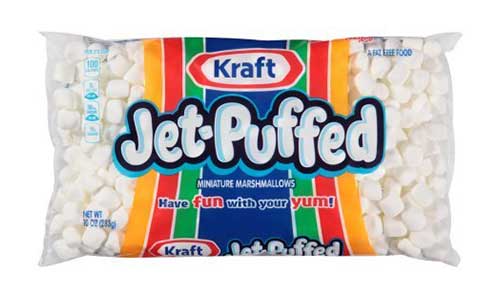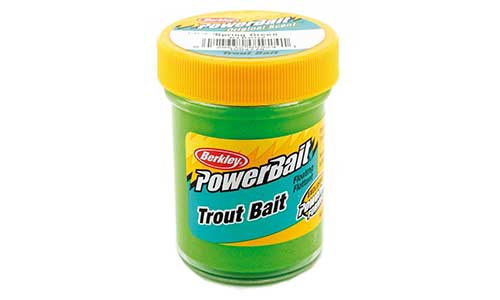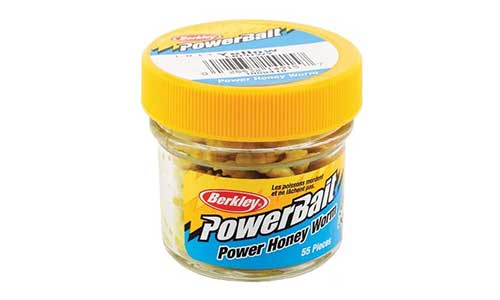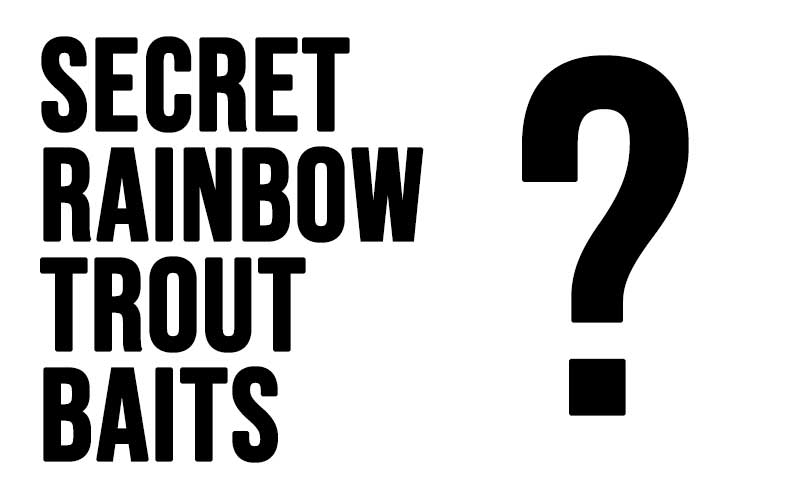Looking for that extra edge over your favorite fishing partner next time you hit the water? In this article, we’re going to take a look at a few less mainstream but extremely fishable baits for trout. Not every bait maker and not every lure company has the marketing budget to advertise their products like some of the bigger more mainstream companies do.
This list is for those who cheer for the underdog, who fight for the guy who doesn’t get the attention that the superstars do. These baits can flat-out outfish the baits that every other trout sees swim by them.
Here are 5 secret Rainbow Trout Baits that not every angler knows about:
- Corn
- Grasshoppers
- Marshmallows
- Berkley Trout Powerbait
- Powerbait Honey Worms
Using Corn for Trout Fishing
Corn can be an extremely effective trout bait for Rainbow trout. I grew up hearing stories from grandpa and other weathered fishermen about how they used to go catch trout all day long at the locally stocked trout lakes with a split shot, small hook, and a can full of corn.
Trout have an amazing sense of smell, and very good eyesight as well. The bright yellow color of a corn kernel mixed with the salty, sweet scent from the canned mixture makes for an excellent rainbow trout bait.

The ideal way to fish corn for Rainbow Trout is with a simple float rig. I personally prefer a slip bobber setup to a traditional spring bobber. The bobber stop allows you to set your depth to target any part of the water column, and also makes it easier to cast when fishing in deeper water.
Place a small split shot about 8-12″ above a size 8 or 10 hooks, then thread one to three kernels of corn onto your hook. A good place to start fishing is one to two feet off the bottom, or right above any subsurface structure such as weed beds or large rocks.
How to Fish Corn for Trout
When it comes to trout fishing, many anglers will tell you that it’s all about presentation. This means making sure you “present” your bait perfectly or as accurately as possible in the trout’s feeding path.
Trout lurking below are constantly facing upstream as the current acts like a conveyor belt that brings them food. In order to properly present Corn to a stream trout, start by threading a kernel of canned corn onto a small single hook.
If the bottom or curved section of your hook is not fully covered by the kernel, add another to fill the space.
Now that your corn is on the hook, it’s time to complete the rig. One of the most popular ways to fish corn for stream trout is to simply place a small split shot about 8-12 inches in front of your baited hook. The weight will bring your bait down towards the bottom where the hungry trout lay and wait.
The current from the river will allow your bait to naturally drift just above the bottom, waiting to be gobbled up by a hungry Rainbow trout.
Another common way to fish corn on lakes or rivers is with a slip bobber setup. The slip bobber gives you many advantages when presenting a bait and targeting trout.
- Control the depth of the bait with ease by adjusting your bobber stop.
- Visually see when your bait/hook has been eaten (or snagged).
- It also allows you to target deeper water not fishable with diving or floating baits.
One of the most common places to fish with a bobber for big rainbows is in lakes. In deeper water trout are often found close to the bottom, which makes the slip bobber an ideal choice to target them.
Trout can also be suspended in the water column depending on the time of day/year, so the adjustability the slip bobber provides is huge.
If you’re taking your slip bobber setup to the stream, try setting your bobber stop to target the deeper sections at the end of runs, also known as pools. Try to keep your line up and out of the current, so you make the corn look like it’s floating along as naturally as possible.
Grasshoppers
These long-legged little insects are like a fresh glazed doughnut for a trout. Packed with nutrients and readily available throughout most of the country, the grasshopper can be a deadly trout tactic if fished at the right time under the right conditions.
The grasshopper is a much more common bait for fly fishing than it is for spin fishermen. Large foam grasshopper imitations, otherwise known as “hoppers” are a late summer favorite among many fly fishermen.

The hopper allows fly anglers to target trout of all sizes, small and large, all on topwater action. This can be one of the most exciting and entertaining ways to hook into a Trout.
How to Fish Grasshoppers for Trout
The first thing you’re going to want to do is to check with your local fishing regulations for live bait. Many of the best trout states have a certain season when live bait can and cannot be used.
If it’s legal, grab a single small hook and hook your grasshopper through the middle of it’s back. There is no wrong or right way to do this, so don’t be afraid to try out different methods to see what works.
If you are using a smaller rod with light action, you may be able to fish the hopper without a sinker. It all comes down to presentation and the size of the water you are fishing. For smaller streams, you can flick your hopper right up next to the bank, as close to any structure or overgrown weeds that you can find.
During the mid to late summer months when the weeds get long and tall, they tend to hang over the edges of the bank and over the water. This provides excellent cover for Trout as it usually stays shaded during those scorching summer days. It also provides a great opportunity for grasshoppers to “walk the plank” so to speak over the edge of a stream.
Spin anglers can use grasshoppers or crickets for Trout with great effect too. One of the most common ways to fish with cricket is to fish the bait under the water. The setup is very similar to fishing with a worm or nightcrawler. Place a grasshopper on a small hook, below a section of split shot.
You can work this setup upstream in moderate current, but most of the time the most successful way to fish this setup is by casting down and across the stream and letting the bait drift across, just like swinging streamers. Try to get your grasshopper in front of areas where trout are likely to be holding: mainly current seams, undercut banks, or behind protruding rocks/boulders.
Marshmallows for Trout Bait?
No, I am not kidding! I have caught a plethora of trout using marshmallows alone but also combined with other baits as well. A small marshmallow is a perfect size bait for trout of any size to eat. Another benefit of fishing with marshmallows is that they float, which means that with the proper setup you can position that bait right where it needs to be in the water column. It doesn’t matter if you’re fishing in a lake or in a river, the marshmallow can be used with success.

Trout have a tremendous sense of smell, and the marshmallow is made of sugar, which when dissolved in the water does give off a very sweet smell. Another great benefit is that they take scent really well. One of my favorite ways to fish with the Marshmallow is “soaking” it in a trout scent, like the Pro-Cure Super Sauce Trout scent.
Another one of my favorite strategies is to use the marshmallow with a small piece of bait, usually a small chunk of nightcrawler, red worm, or wax worm. This gives the bait just a little extra scent and a slightly bigger profile, but it also helps to reduce the buoyancy of the bait which can be a great way to fish it in slower-moving pools in rivers or streams.
Marshmallow Trout Bait Setups
My favorite setup for fishing lakes (especially from shore) is a simple bottom fishing rig. A small straight shaft hook with a marshmallow threaded on. About 12 inches up from the hook is a selection of split shot. This positions the bait right above the bottom.
I use a similar setup when fishing in streams and rivers, except I usually use a small 1/16oz. jig head and a small worm along with the marshmallow. The only variable with this setup is how much split shot I am using and how far above the hook I place them. In lakes and ponds, trout tend to move throughout all sections of the water column, but in rivers and streams, they really tend to favor the bottom, so that’s where I like to position my bait.
Berkley Trout Powerbait
Another one of my favorite baits that isn’t as popular with a lot of anglers is Berkley’s Trout Powerbait. This special formula comes in various different color combinations and has a special scent that trout really seem to love. Although the name of this bait has the word Trout right in it, I find a lot of fishermen I’ve run into would use live bait such as a nightcrawler or wax worm before ever reaching for a jar of Powerbait.

Although live bait does have its time and place, I have found Powerbait to be very effective in certain scenarios. The formula is made so that the bait floats in the water, which limits the ways in which you can fish it to a certain extent. Powerbait comes in a variety of colors and contains a natural fishy-like scent. Check out our article on the best Powerbait Colors for Trout for more info on how to find the right color. I find that Trout Dough typically works best on stocked fish. This is because stocked or hatchery-raised fish grew up eating small pellet-sized food.
Trout Dough Rigs
One of my favorite methods to fish Berkley Powerbait is below a slip bobber setup. This is a very simple setup that allows you to manually change the depth at which your bait is presented. Start with a small size 14 to size 10 hook depending on your preference. I would place a small split shot 8-12 inches above the hook to help keep your bait down.
Then, above your split-shot use a slip Bobber of your choice. I prefer to use the black and orange Bobbers from Thill in small to medium size. Most slip bobber set-ups come with a small fluorescent bead and bobber stop to complete the setup. The fluorescent bead prevents the bobber from getting caught in the bobber stop which sets your depth.
Trout tend to lie on the bottom of the river as they feed. They face upstream and wait for food to come to them sort of like a conveyor belt. Utilizing a slip bobber allows you to Guess and check to make sure your bait is at the right depth. the first places I would Target our deeper runs and pools. Don’t be afraid to let more line out as your fiber floats Downstream to extend your drift.
Another method for using trout powerbait is a simple bottom-feeding setup. If you are fishing in a lake place a small split shot 8 to 12 in above a hook with the trout dough attached then cast your line into the water from the bank slowly realizing until the line is taught. You’ll see your Rod make small tapping emotions when you have a bite. You can use a similar set up for fishing rivers, just use the right amount of weight so that your bait is near the bottom but still floats downstream.
Powerbait Honey Worms for Trout
Another useful but relatively unknown trout bait is the power bait honey worm. This bait is made by Berkley and looks similar to a natural wax worm or mealworm. Many trout across the United States spend most of their time feeding subsurface on small invertebrates. The honey worm looks like a general larva that could be floating downstream after being kicked up from the river’s substrate.
These scented baits come 55 in a jar and measure 1 inch long. They come in three different colors: red, natural, and yellow. You can use the Honey Worm very similar to other bait set-ups. This bait works great on a floating rig but also on a bottom fishing rig with a hook and small weight. The honey worm is also an exceptional ice fishing bait and can be used for multi-species fishing as well.

I have found that my best luck with honey worms has come on the natural colors during Bright Days. after long periods with no rain, my local streams are very clear. Lighter colors work better on lighter days and the natural honey worm when fished subsurface usually gets bit by more than one trout.
